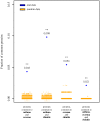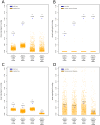Computational analysis of multimorbidity between asthma, eczema and rhinitis
- PMID: 28598986
- PMCID: PMC5466323
- DOI: 10.1371/journal.pone.0179125
Computational analysis of multimorbidity between asthma, eczema and rhinitis
Abstract
Background: The mechanisms explaining the co-existence of asthma, eczema and rhinitis (allergic multimorbidity) are largely unknown. We investigated the mechanisms underlying multimorbidity between three main allergic diseases at a molecular level by identifying the proteins and cellular processes that are common to them.
Methods: An in silico study based on computational analysis of the topology of the protein interaction network was performed in order to characterize the molecular mechanisms of multimorbidity of asthma, eczema and rhinitis. As a first step, proteins associated to either disease were identified using data mining approaches, and their overlap was calculated. Secondly, a functional interaction network was built, allowing to identify cellular pathways involved in allergic multimorbidity. Finally, a network-based algorithm generated a ranked list of newly predicted multimorbidity-associated proteins.
Results: Asthma, eczema and rhinitis shared a larger number of associated proteins than expected by chance, and their associated proteins exhibited a significant degree of interconnectedness in the interaction network. There were 15 pathways involved in the multimorbidity of asthma, eczema and rhinitis, including IL4 signaling and GATA3-related pathways. A number of proteins potentially associated to these multimorbidity processes were also obtained.
Conclusions: These results strongly support the existence of an allergic multimorbidity cluster between asthma, eczema and rhinitis, and suggest that type 2 signaling pathways represent a relevant multimorbidity mechanism of allergic diseases. Furthermore, we identified new candidates contributing to multimorbidity that may assist in identifying new targets for multimorbid allergic diseases.
Conflict of interest statement
Figures




Similar articles
-
A novel whole blood gene expression signature for asthma, dermatitis, and rhinitis multimorbidity in children and adolescents.Allergy. 2020 Dec;75(12):3248-3260. doi: 10.1111/all.14314. Epub 2020 Apr 23. Allergy. 2020. PMID: 32277847 Free PMC article.
-
Prevalence and Risk Factors of Asthma, Rhinitis, and Eczema and Their Multimorbidity among Young Adults in Kuwait: A Cross-Sectional Study.Biomed Res Int. 2017;2017:2184193. doi: 10.1155/2017/2184193. Epub 2017 Aug 30. Biomed Res Int. 2017. PMID: 28951868 Free PMC article.
-
IgE antibodies in relation to prevalence and multimorbidity of eczema, asthma, and rhinitis from birth to adolescence.Allergy. 2016 Mar;71(3):342-9. doi: 10.1111/all.12798. Epub 2015 Dec 22. Allergy. 2016. PMID: 26505741
-
Atopic phenotypes and their implication in the atopic march.Expert Rev Clin Immunol. 2020 Sep;16(9):873-881. doi: 10.1080/1744666X.2020.1816825. Epub 2020 Sep 16. Expert Rev Clin Immunol. 2020. PMID: 32856959 Review.
-
Allergic Rhinitis and its Impact on Asthma (ARIA) Phase 4 (2018): Change management in allergic rhinitis and asthma multimorbidity using mobile technology.J Allergy Clin Immunol. 2019 Mar;143(3):864-879. doi: 10.1016/j.jaci.2018.08.049. Epub 2018 Sep 29. J Allergy Clin Immunol. 2019. PMID: 30273709 Review.
Cited by
-
Turkish Guideline for Diagnosis and Treatment of Allergic Rhinitis (ART).Turk Arch Otorhinolaryngol. 2021 May;59(Suppl 1):1-157. doi: 10.4274/tao.2021.suppl.1. Turk Arch Otorhinolaryngol. 2021. PMID: 34212158 Free PMC article.
-
Correlation of Blomia tropicalis-specific immunoglobulin epsilon profiles with family history of atopy in a Filipino population.Asia Pac Allergy. 2024 Mar;14(1):12-20. doi: 10.5415/apallergy.0000000000000133. Epub 2024 Jan 11. Asia Pac Allergy. 2024. PMID: 38482460 Free PMC article.
-
Early origins of allergy and asthma (ARIES): study protocol for a prospective prenatal birth cohort in Chile.BMC Pediatr. 2020 Apr 15;20(1):164. doi: 10.1186/s12887-020-02077-x. BMC Pediatr. 2020. PMID: 32293348 Free PMC article.
-
Real-world data using mHealth apps in rhinitis, rhinosinusitis and their multimorbidities.Clin Transl Allergy. 2022 Nov;12(11):e12208. doi: 10.1002/clt2.12208. Clin Transl Allergy. 2022. PMID: 36434742 Free PMC article.
-
Relationship Between Rhinitis, Asthma, and Eczema and the Presence of Sensitization in Young Swiss Adults.Allergy Rhinol (Providence). 2018 May 18;9:2152656718773606. doi: 10.1177/2152656718773606. eCollection 2018 Jan-Dec. Allergy Rhinol (Providence). 2018. PMID: 29977657 Free PMC article.
References
MeSH terms
Substances
LinkOut - more resources
Full Text Sources
Other Literature Sources
Medical
Research Materials

